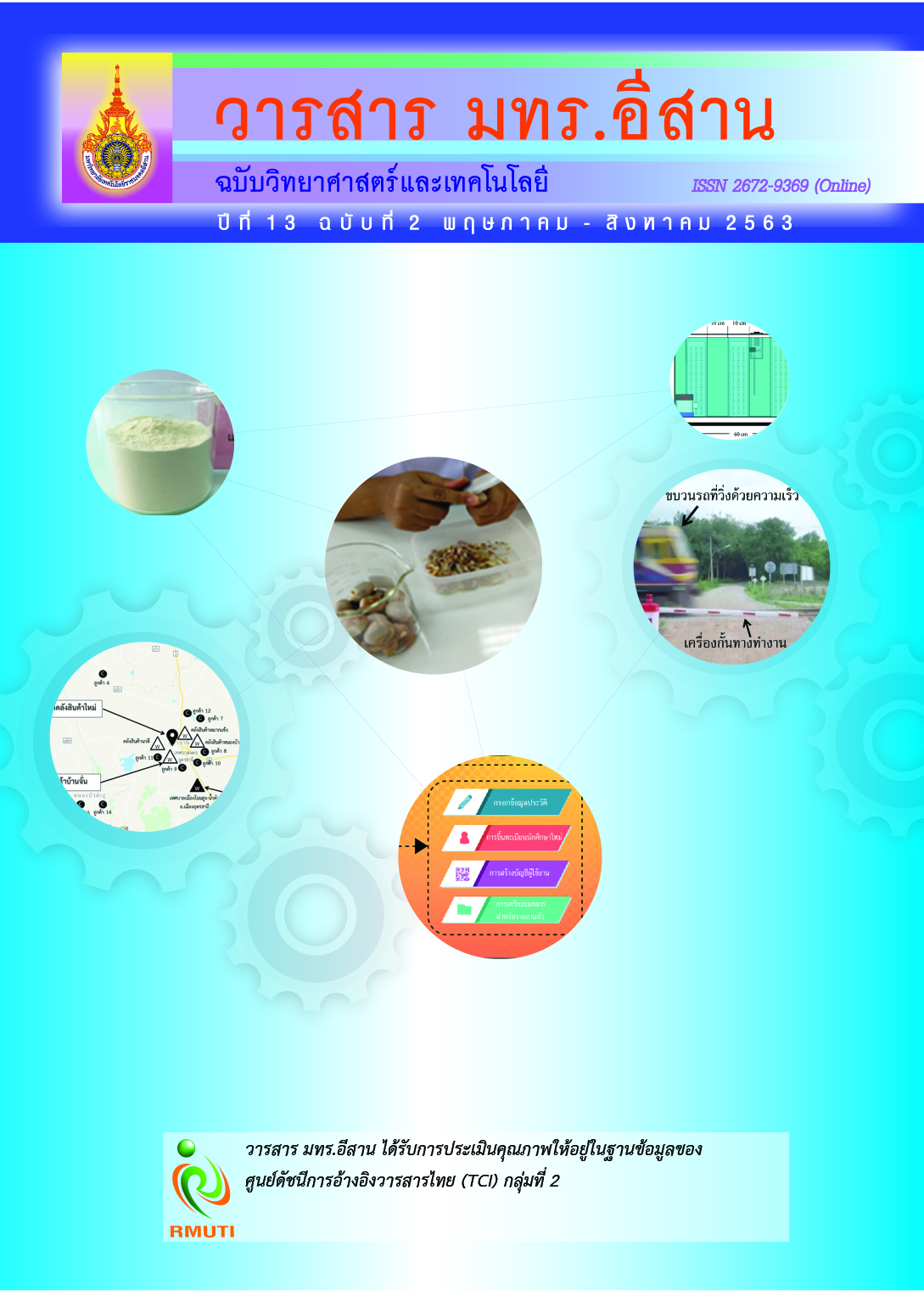ผลของพันธุ์ข้าวโพด ชั้นเปลือกข้าวโพด และวิธีการแยกเส้นใยต่อผลผลิตและสมบัติทางกายภาพของเส้นใยเปลือกข้าวโพด
Main Article Content
บทคัดย่อ
การวิจัยนี้มีวัตถุประสงค์เพื่อศึกษาผลของพันธุ์ข้าวโพด ชั้นเปลือกข้าวโพด และวิธีการแยกเส้นใยต่อผลผลิต และสมบัติทางกายภาพของเส้นใยจากเปลือกข้าวโพด โดยทดลองใช้ข้าวโพด 3 พันธุ์ ได้แก่ พันธุ์อินทรี 2 พันธุ์ไฮ-บริกซ์ 3 และพันธุ์เอทีเอส 12 ชั้นเปลือกข้าวโพด 2 ชั้น ได้แก่ เปลือกชั้นนอกและเปลือกชั้นใน และวิธีการแยกเส้นใย 6 วิธี ได้แก่ วิธีที่ 1 การใช้สารละลายด่างความเข้มข้น 2.5 กรัมต่อลิตร วิธีที่ 2 การใช้สารละลายด่างความเข้มข้น 5.0 กรัมต่อลิตร วิธีที่ 3 การใช้สารละลายด่างความเข้มข้น 2.5 กรัมต่อลิตร และสารละลายเอนไซม์ 0.5 % วิธีที่ 4 การใช้สารละลายด่างความเข้มข้น 2.5 กรัมต่อลิตร และสารละลายเอนไซม์ 1.0 % วิธีที่ 5 การใช้สารละลายด่างความเข้มข้น 5.0 กรัมต่อลิตร และสารละลายเอนไซม์ 0.5 % และวิธีที่ 6 การใช้สารละลายด่างความเข้มข้น 5.0 กรัมต่อลิตร และสารละลายเอนไซม์ 1.0 % จัดสิ่งทดลองแบบ 3 2 6 แฟคทอเรียล ในแผนการทดลองแบบบล็อกสุ่มสมบูรณ์ทำการทดลอง 3 ซํ้า ผลการวิจัยพบว่า พันธุ์ข้าวโพดมีผลต่อผลผลิตและขนาดเส้นใย (p0.01) ชั้นเปลือกข้าวโพดมีผลต่อความยาวและความหยิกงอของเส้นใย (p
0.01 และ 0.05 ตามลำดับ) วิธีการแยกเส้นใยมีผลต่อผลผลิต ความยาวและขนาดของเส้นใย (p
0.01) ปฏิสัมพันธ์ระหว่างพันธุ์ข้าวโพดกับชั้นเปลือกข้าวโพดมีผลต่อผลผลิต ความยาว ขนาดและความหยิกงอของเส้นใย (p
0.01 0.01 0.05 และ 0.05 ตามลำดับ) ปฏิสัมพันธ์ระหว่างพันธุ์ข้าวโพดกับวิธีการแยกเส้นใยมีผลต่อผลผลิต ความยาวและความหยิกงอของเส้นใย (p
0.01 0.01 และ 0.05 ตามลำดับ) ปฏิสัมพันธ์ระหว่างชั้นเปลือกข้าวโพดกับวิธีการแยกเส้นใยมีผลต่อผลผลิตเส้นใย (p
0.01) และปฏิสัมพันธ์ระหว่างพันธุ์ข้าวโพด ชั้นเปลือกข้าวโพดกับวิธีการแยกเส้นใยมีผลต่อผลผลิตและความยาวเส้นใย (p
0.01)
Article Details
เอกสารอ้างอิง
Boonrueang, S. and Chankroot, A. (2008). Handbook of Agricultural Extensionist: Corn (Animal Feed Corn and Sweet Corn). Bangkok: Bureau of Agricultural Commodities Promotion and Management, Department of Agricultural Extension
Suteerapoj, W. (2019). Canned Vegetables and Fruits: 2019 Export Target, Export in January 2019. Access (7 September 2019). Available (https://ditp.go.th/ewt_news_ditp2. php?content=539767&cate=751&d=)
Yilmaz, N. D., Sulak, M., Yilmaz, K., and Kalin, F. (2016). Physical and Chemical Properties of Water-Retted Fibers Extracted from Different Locations in Corn Husks. Journal of Natural Fibers. Vol. 13, No. 4, pp. 397-409
Sricharassin, W. (2009). Story of Pineapple Fabric (Not Pineapple). Colourway. Vol. 15, No. 85, pp. 21-25
Konczewicz, W. and Kozlowski, R. M. (2012). Handbook of Natural Fibres Volume 2: Processing and Applications. Cornwall, UK: TJ International Ltd., Padstow
Udomkijdecha, V. (1999). Fiber Science. Bangkok: Chulalongkorn University Printing House
Yilmaz, N. D. (2013). Effect of Chemical Extraction Parameters on Corn Husk Fibres Characteristics. Indian Journal of Fibres and Textile Research. No. 38, pp. 29-34
Goswami, B. C., Anandjiwala, R. D., and Hall, D. M. (2004). Textile Sizing. New York: Marcel Dekker, Inc.
Cook, J. G. (2001). Handbook of Textile Fibers Vol. 1 Natural Fibres. 6th ed. Delhi: Replika Press Pvt Ltd.
Haruthaithanasan, V., Noijaiboon, V., Ujjin, S., Senatham, S., Kwuandee, T., Tulpijit, P., Chollakup, R., Pasookdee, W., and Pochanakul, V. (2004). Pilot Project of Pineapple Leaf Fiber Utilization for Textile Industry. Final Report, The Thailand Research Fund.
Kawruang, W. and Limmanee, S. (2013). Lotus: Fiber from Furrent to Green Textile Innovation. Colourway. Vol. 18, No. 105, pp. 4-52


